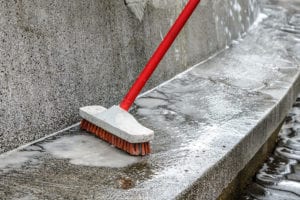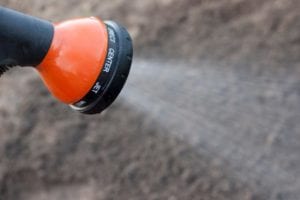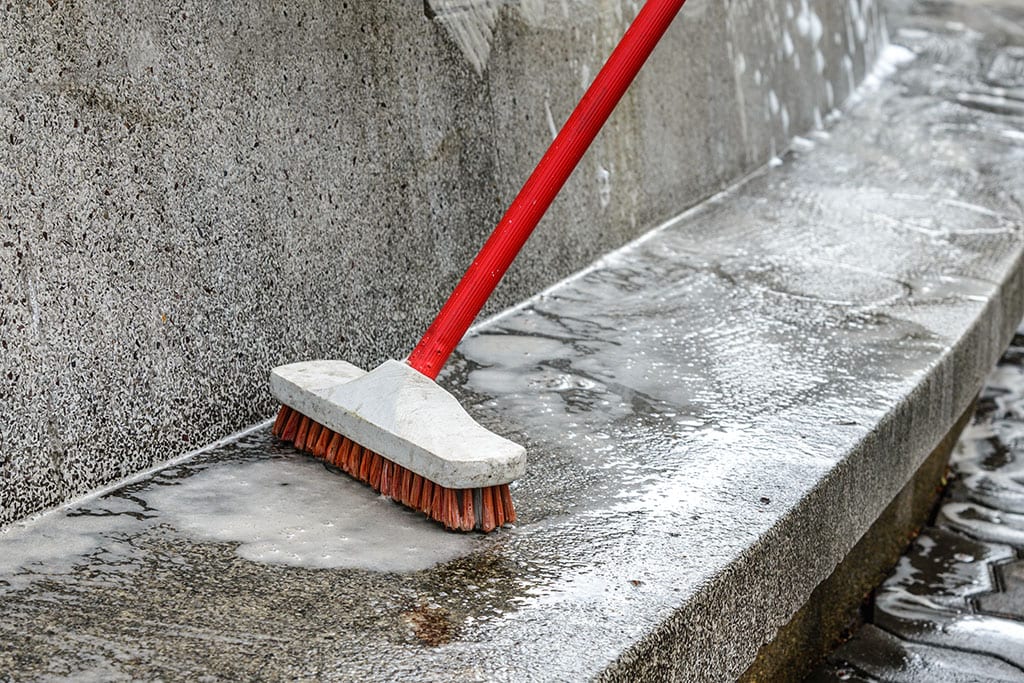
08 Oct Outdoor spaces – Revive And Seal Your Concrete
Subscribe to our newsletter
How To Clean Unsealed Concrete
Spring is here and summer is just around the corner! With the longer days and the chill of winter long gone, a lot of people get into the spring-cleaning mood. It’s almost like it is part of a yearly ritual, rooted in tradition. The sense of satisfaction and accomplishment in getting the place spruced up for the summer season is a big drive for many people.
One effective way to keep your concrete driveway, walkway, walls, pool deck, patio, courtyard and alfresco entertaining area looking great and inviting, is to give the concrete a good clean by removing any debris, stains, weeds, algae and other organic growth – and seal it.
Even though concrete is a tough and durable product, it is still subject to wear and tear from natural elements and general daily use. When sealed, your concrete will be protected from liquid sinking into the pores of the concrete. It provides a durable chemical protection that reduces the chance of concrete staining and keeps it looking clean and new for longer. Sealing the concrete will not only protect your concrete from water penetration, stains and prolong its service life, but it will also make the subsequent cleaning of your concrete a lot easier.
How to clean concrete without a pressure washer
Stains can easily embed into the pores of unsealed concrete and can be difficult to remove. Cleaning concrete with a pressure washer is effective, but if you do not have one, take a look at our tips on how to effectively give your concrete a thorough clean.
Three main points:
- Choose the right cleaning agent
- Use the right type of brush/broom
- Rinse well with a garden hose
Choosing the right cleaning agent.
The key is to determine what kind of stains and dirt you have on your concrete to find what type of cleaner that is best suited for removing those.
- PH Neutral. It is a mild cleaner that is ideal for indoor or lightly dirty exterior concrete.
- Acidic. It is generally used for removing rust stains, dirt, and efflorescence on concrete. It is often used for the preparation of the concrete surface before installing a sealer.
- Alkaline. This is used as a degreaser to remove oil stains, effectively cleaning up garage floors and driveways where cars often are parked.
- Enzymatic/bacterial concrete cleaners are effective in cleaning organic matter such as mould and protein stains. This cleaner helps kill bacteria and lift those stains.
Once you have chosen a suitable cleaner, follow the manufacturer’s instructions carefully and always check the safety data sheets to ensure that you take the appropriate safety measures.
If there are areas such as wood, glass, metal and plants that you do not want the cleaning agent to be in contact with, be sure to cover those areas. Once prepared, apply the cleaning solution.
The cleaning agent can be applied by using a low-pressure spray pump. Work the cleaner into the concrete by brushing the concrete with a deck brush* (no metal bristles) that is designed for the type of chemical you are cleaning with so that the bristles do not disintegrate.
Follow the manufacturer’s instructions on how long to let the cleaning product sit on the concrete before and after using the brush.
If the chemical is to sit undisturbed on the concrete before using the brush, consider misting it with water rather than spraying it with a hose to keep the cleaning agent from drying while you wait.
Once you have finished scrubbing the concrete with the deck brush, generously rinse the concrete with a garden hose and make sure that the cleaning agent is washed off completely. If the stains and dirt are not quite removed, repeat the process and/or use a pressure washer.
- Cleaning tips for unsealed concrete – Waterstop Solutions
* If cleaning with a brush, make sure not to use a metal bristle brush because small parts of the metal bristle may break off and embed into the concrete, which likely will lead to rust stains.
Penetrating water repellent sealers for concrete and masonry protection
Sealers are essential for building protection and are used for a wide variety of purposes. The biggest benefit of having the concrete sealed is that the concrete is protected from water absorption, thus helping extend its lifespan. Besides keeping the concrete dry, it also helps keep dirt particles, oils, food and drink spills from penetrating into the pores of the concrete. In that way, it is much easier to clean.
There is a vast collection of different types of concrete sealers and each has its own individual properties. The most commonly used are film-forming sealers (e.g. acrylic, epoxy and polyurethane sealers) and penetrating sealers.
Penetrating sealers are not coatings, whereas film-forming sealers are. Film-forming sealers create a physical protective barrier that sits on top of the surface as a coating and stops the penetration of moisture.
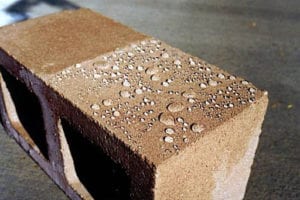
Waterstop Solutions PWR 180+
It is easy to apply and very effective without altering the look of the concrete.
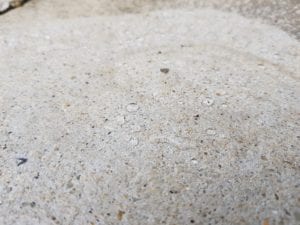
Image: Penetrating Water Repellent PWR installed. Water beads on top of the concrete slab surface.
We employ the latest waterproofing technology in a range of systems applicable to porous substrates, such as concrete, brickwork, mortar or stone.
Waterstop Solutions PWR 180+ (Penetrating Water Repellent) is a low viscosity, silane-siloxane system that can be applied on new and old, cleaned concrete and masonry. The sealer penetrates deep into the porous substrate, creating a bonded hydrophobic lining to the pores.
By creating a bonded hydrophobic lining to the pores, the penetrating water repellent (PWR) makes concrete and masonry less porous. This means that the treated surface will repel water and resist staining from leaves, oil leaks and grease as well as protect against waterborne salts. It also does an excellent job of resisting mould, mildew, and fungus. (Please note that a spill that is left to sit, can eventually stain the surface.)
This treatment significantly reduces the absorption of water and waterborne salts while also being “breathable”, which means that it allows moisture to migrate through the surface as a vapour. This is a very important feature. Waterstop Solutions PWR can also be used as a chemical damp-proof course (DPC). It prevents rising damp through capillary action in masonry, brickwork and stonework structures.
The solution does not produce any discolouration of the substrate. It has a dry-look finish and has excellent resistance to weathering.
Common areas where Penetrating Water Repellent (PWR) sealer is used:
- Concrete
- Brickwork, masonry blocks
- Tiles and grout
- Pool surrounds
- Some natural stones
- Traditional and modern stucco and render
- Paths and traffic-bearing surfaces
Key benefits of Waterstop Solutions PWR 180+
- Provides an invisible water repellent surface. Maintains the texture and colour of the surface treated. Invisible, dry and natural look finish.
- Allows the passage of water vapour.
- Excellent water repellent of concrete, concrete blocks, brickwork, pavers, tiles, tile grout and some natural stones.
- Long-lasting barrier against efflorescence and surface salts, moisture and chemical attacks.
- Prevention of dirt retention and deep stains.
- Enabling easier removal of graffiti.It speeds up graffiti removal, which is a great benefit for areas such as:
- Shopping centres, schools, universities, commercial buildings and walkways
- Public areas, council property and heritage buildings
- Roads, along highway and public transport infrastructure
- Reduces cleaning costs. No more scrubbing or power washing. The PWR sealant decreases dirt adhesion and prevents moss and mould growth. (Rainfall or a light garden hose wash is enough.)
- Reduction of sandstone decay due to attack by salts and low pH precipitation.
- Elimination of white salt spotting on brickwork.
- Treatment of rising and salt damp.
- Acts as a replacement of damp-proof course (DPC).
- Helps maintain a great curb appeal and sale value with a new-look preservation.
We have a wide range of sealers, membranes and coating products we can recommend to meet your different requirements and expectations. There are many considerations to take into account when choosing the right coating for a project. Our experienced team is happy to help you with identifying and selecting the protective coating, membrane or penetrative sealer to suit the requirements of your project.
Check out our Waterstop Solutions logo created with our own PWR (Penetrating Water Repellent) treatment!
It is INVISIBLE when the ground is DRY, but with today’s rain it really stands out!
See how the water is beading on the concrete in the close-up photo!
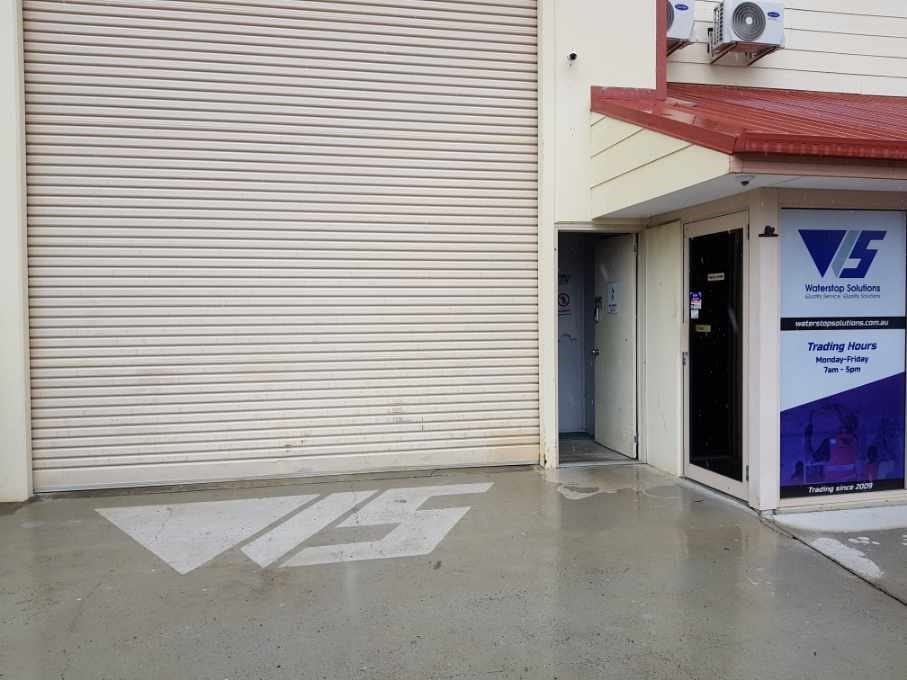
Image: The Waterstop Solutions logo is the PWR-treated area. It is light grey in colour because it has not soaked up water. The untreated concrete has soaked up water and is darker in colour.
Waterstop Solutions penetrating sealant treatments
We employ the latest waterproofing technology in a range of systems applicable to porous substrates, such as concrete, brickwork, mortar or stone.
Depending upon your application, one of these systems may be a more economical option with the added benefits of introducing minimal change to the surface appearance of the original substrate and requiring very low to zero maintenance.
One such water-based treatment is our Hardener Densifier. The hardener densifier treatment reacts with moisture and the free lime or calcium in concrete to permanently improve concrete abrasion resistance, reduce dusting and porosity for easier maintenance, and help heal minor static cracks, thus greatly extending the life of ageing substrates.
Suitable for a wide range of applications such as:
- New and remedial waterproofing
- Dust proofing
- Reducing mould and dirt build-up
- Reducing cleaning costs and slip hazards
If you have any issues with water ingress, cracking concrete slabs, structural cracks, concrete deterioration, moisture, seepage, efflorescence, rising damp and/or high-flow active leaks in concrete structures, we would be happy to assist you. You are welcome to contact us with any questions that you may have.
Brisbane office: (07) 3205 1899
Email: [email protected]
Sydney office: (02) 9346 8308
Email: [email protected]
Are you interested in finding out more about the various remedial building services we are providing?
Please click on the image below to download Waterstop Solutions Capability Statement
Waterstop Solutions Capability Statement is now available to download as PDF. (The image is clickable and opens up a link to our Capability Statement).
Good maintenance begins with a proactive approach to maintain, keep, preserve and protect a building.
Remember that seepage/water ingress into areas such as balconies, basements, concrete roofs, car parks and retaining walls, should not be ignored – call a remedial waterproofing professional today for an assessment to provide you with the best solution for your situation.
At Waterstop Solutions, we carry out a wide range of remedial works to concrete structures post-construction stage in Brisbane, Gold Coast, Sunshine Coast, Sydney and outlying areas in Queensland and New South Wales.
Equipped with major civil works experience, we can quickly determine the best approach to rectify all seepage and concrete deterioration issues.
It takes licenced remedial waterproofer and leak sealing experts like us at Waterstop Solutions to ensure that the pathways for water to ingress are properly sealed off. A depth of technical knowledge and experience, along with a proud reputation for integrity and reliability, has made Waterstop Solutions the go-to company for many Defect Managers working for major construction companies across Queensland and New South Wales.
We at Waterstop Solutions have the technical and practical expertise to diagnose the source of the leak and will provide you with our recommended solution to achieving an effective, high-quality, long-lasting repair to stop the water ingress with minimal disruption
We believe in and are committed to always delivering high-quality solutions by utilising the right products and techniques for each specific project combined with our industry-leading know-how on tap. We have a large talent pool of specialist leak sealing and concrete repair technicians with Certificate III in construction waterproofing in Queensland and New South Wales that are extensively trained in our systems and project execution methods.
The leadership positions on every Waterstop Solutions project are operated by highly qualified, certified and experienced industry professionals. Our in-house skills and expertise gained from more than 60 years of industry experience provide a full range of high-quality remedial waterproofing and concrete repair works to commercial buildings, civil infrastructures, industrial sites and residential properties. From waterproofing diagnostics, preventative and remediation solutions – All of our waterproofing solutions are quality guaranteed.


